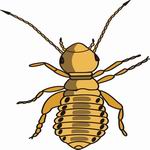- The head louse (Pediculus humanus capitis) is gray in color but tends
to take on the hair color of the host.
- This insect pest is usually found on the lower back of the head and
behind the ears.
- The female is about 1/16" to 1/8" long and flattened in
shape; the male is a bit smaller.
- Hook-like claws are at the end of each of six legs to help anchor
the louse to the hair shaft.
- Head lice do not jump or fly.
- A female head louse will live about 30 days on a host.
- During this period, she will deposit about 90 eggs, three a day.
- The grayish white, 1/16" long eggs are cemented to hair shafts
next to the scalp.
- The eggs are called "nits" and hatch in about one week.
- The newly hatched lice (called "nymphs") molt three times
in eight or nine days before becoming adults.
- The life cycle is completed in about 15 days. During this time, the
nymphs, as well as the adults, feed with piercing and sucking mouthparts,
injecting saliva to keep blood from clotting.
- If the lice are not disturbed, feeding may continue for extended periods,
and the insects may excrete dark red feces onto the scalp.
- The first major symptom of a louse infestation can be intense itching
caused by the louse's feeding, although certain individuals may not
experience itching at all.
- Breaks in the skin caused by the louse and resultant scratching can
cause secondary bacterial skin infection, especially in the absence
of good hygiene.
- Human lice do not usually infest pets or other animals
|


